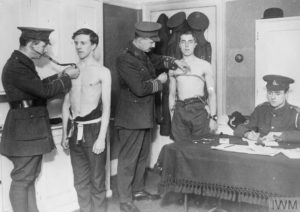Monday October 21st, 1918
Marked out of Hospital to Battalion. In billets at Elincourt. Am with Bob Prenty and found G. Thompson safe and sound.
Re-united at Elincourt
Today both Frank and the Battalion move to Elincourt. For Frank the journey is about 4kms south of Maretz and for the Battalion about 8kms from Maurois where they rested last night. Frank, having been in hospital for a fortnight, is reunited with Bob Prenty and checks up on other comrades. It must have been strange for Frank to have lived, worked and trained in a Battalion for 10 months only to have then missed out on its first major offensive action. Probably he felt a combination of relief and let-down.
Despite all Frank’s health problems, he was obviously ‘Grade I’ material when he went through his medical examination to join the Army only 18 months ago.
National Physique and Public Health

All prospective service men were classified according to their fitness through a medical examination. This provided some disturbing insights into the health of the British male population, where the national average in Grade I was only 34%.
Yesterday, the Observer contained an article by the architect of this analysis, Professor Arther Keith. He included results that were even worse than those I described in my earlier posts.
Professor Keith’s expectation of a typical cadre of 1,000 young men was: Grade I – 70%; Grade II – 2o%; Grade III – 7.5%; and Grade IV – 2.5%. Yet the results yielded by large industrial towns by 1917/18 was as follows: Grade I – 19%; Grade II – 27%; Grade III – 41%; and Grade IV – 13%.
While it could be argued that by 1917/18 most able-bodied, younger men were already at war, Keith also analyzed the results from previously protected trades. These came in at: Grade I – 27%; Grade II – 15%; Grade III – 16%; and Grade IV – 42%.¹
Nothing New
Interestingly, a similar analysis completed at the end of the Boer War, though less scientific, had shocked the nation. General Sir Frederick Maurice had estimated that of 1,000 potential recruits only 40% made it into the Army. He declared ‘Six companies of a hundred men each had been placed ‘hors de combat’ by the warfare of civilian life before the battalion had left the parade ground.’
Fifteen years later, nothing much had changed. However, with a war of attrition in full spate, the audience was probably more receptive. Lloyd George himself was quoted to say,‘If we only had that million this war would have ended triumphantly.’
Professor Keith suggested that in addition to measuring births and deaths, we should also be interested in ‘the health and fitness of the nation‘.¹
The Solution
However I found Professor Keith’s solutions outrageous, and worth quoting:
‘If we determine to allow men and women to live contentedly under slum conditions if they should so choose, then we must be prepared for a type of manhood of the lower grade. The great lesson of the war is that slums produce children which grow up into III and IV. …
If we fail to induce women, by compensation or some such means, to forgo the privilege of wage-earning when their children demand all their care, we must be prepared for a preponderance of men and women who are physically as unfit for civil as for military duties – men and women of Grades III and IV. There are whole trades working under such conditions that scarcely a man of them at the age of forty retains his health.’¹
Needless to say, this led to several letters to the newspapers, including one printed the following Sunday, which stated:
‘The two counties and two towns in the UK where the highest infant death rates prevail are the counties of Durham and Glamorgan and the town of Sunderland and Middlesborough – all districts where there is no industrial employment for women.’²
All of which points to tensions in post-WWI Britain – both the creation of a ‘land fit for heroes’ and one of women’s suffrage.
9th Battalion War Diary – 21st October 1918 – Elincourt
The Battalion marched to Elincourt for a period of rest and reorganized on the basis of 3 platoons per Coy. Captain FT Taylor MC having rejoined the Battalion is taken on the effective strength and assumes command of B Coy. 2/Lt W Fairbrother having joined the Battalion is taken on the effective strength and posted to B Coy with effect from 20-10-18.
References & Further Reading
¹ ‘National Physique and Public Health, Appalling Figures’ by Professor Arthur Keith, The Observer, October 20, 1918, page 3
² Letter from Mrs FK Streatfield, The Observer, October 27, 1918, page 3
* Q 54351, copyright Imperial War Museums


